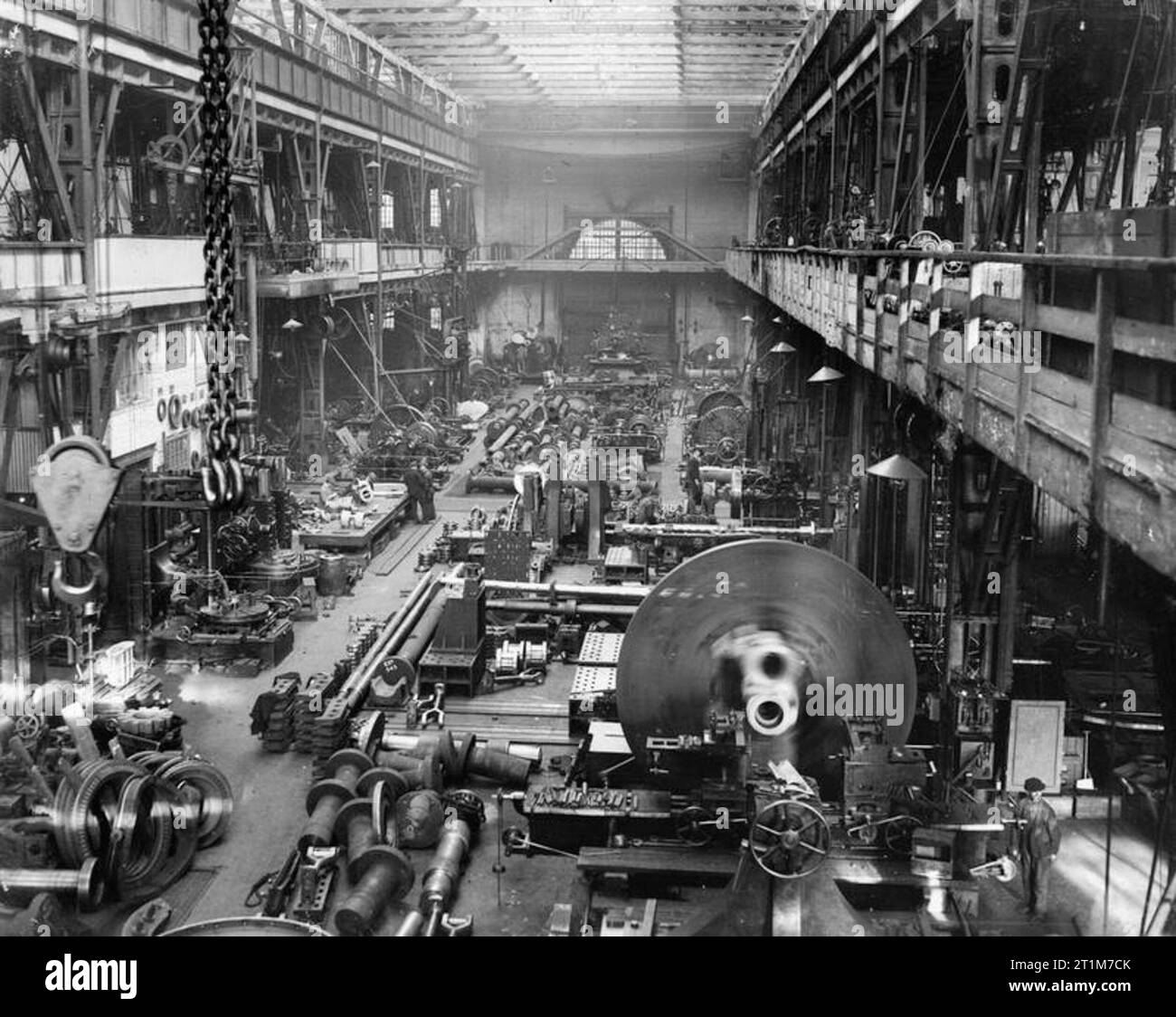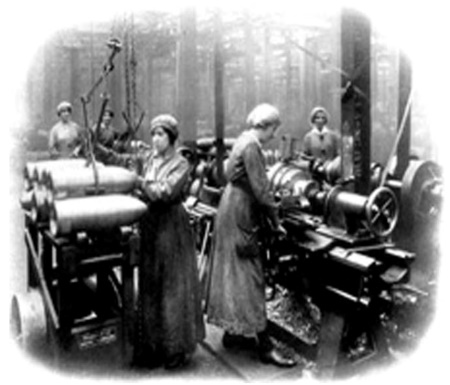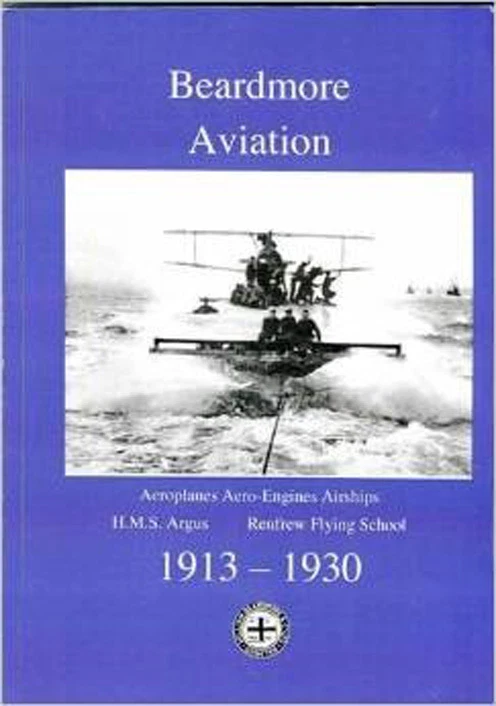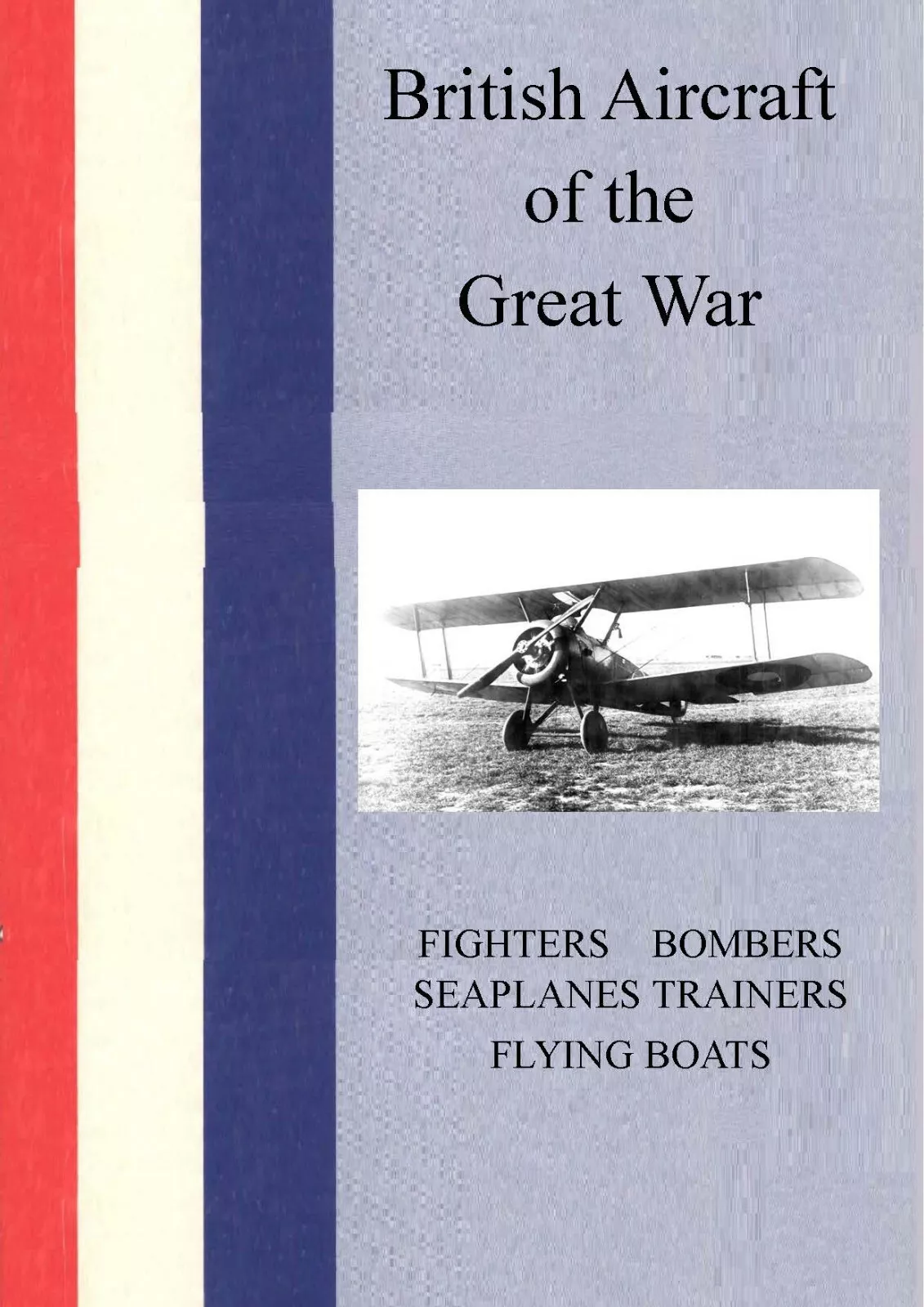Heavy industry to air power: Scotland's Clydeside aviation transformation.
Introduction: Scotland's Industrial Flying Revolution
Clydeside's transformation from shipbuilding powerhouse to aviation producer was deliberate, structured, and sustained. Based on comprehensive research documented in Charles E. MacKay's authoritative works Clydeside Aviation Volume One: The Great War and Beardmore Aviation, this Enhanced Edition presents the complete story of how Scotland's industrial capabilities transformed into aviation manufacturing excellence.
The book Clydeside Aviation Volume One provides a detailed description of the history of Aviation on Clydeside from 1785 to 1919. This comprehensive 372-page work profusely illustrated with over 450 illustrations and drawings commences with the balloonist Vincent Lunardi of 1785 in Glasgow, then Percy Pilcher flying at Cardross. The book includes fresh details of Pilcher and his flights at Cardross and his death flight, A. B. Baird and his monoplane on the Isle of Bute and Harold and Frank Barnwell at Grampian Motor Works, Stirling. This comprehensive documentation ensures that Clydeside aviation development is properly understood within the broader context of Scottish industrial history.
Steel, machining, foundry work, fabrication, logistics, and managerial experience — the core competences of the Clyde — were mapped to airframes, engines, propellers, and ship‑scale lighter‑than‑air structures. What emerged was a uniquely Scottish contribution to British air power across two world wars and the inter‑war decades: disciplined manufacturing at pace, grounded in inspection culture and systems thinking.

Early Foundations: From Balloons to Gliders (1785-1914)
The book commences with the balloonist Vincent Lunardi of 1785 in Glasgow, establishing the earliest foundations of Scottish aviation. This early balloon activity demonstrates how Scotland's aviation heritage extends back to the very beginnings of human flight. The comprehensive documentation of early aviation ensures that Clydeside's aviation origins are properly understood.
There are fresh details of Percy Pilcher and his flights at Cardross and his death flight. Pilcher's pioneering work represents Scotland's earliest systematic aviation experiments, demonstrating how Scottish engineering expertise supported early aviation development. The comprehensive documentation of Pilcher's work ensures that his contributions to Scottish aviation are properly recognized.
A. B. Baird and his monoplane on the Isle of Bute and Harold and Frank Barnwell at Grampian Motor Works, Stirling represent additional early Scottish aviation pioneers. These pioneers demonstrate how Scottish engineering expertise supported early aircraft development. The comprehensive documentation of these pioneers ensures that their contributions are properly preserved.
This is followed by the Denny Mumford Helicopter, the formation of the Scottish Aeronautical Society and the Ashton Lane murder, the Exhibition at Kelvingrove of 1911, with a description of the disastrous fire: the Lanark meeting of 1910 and the Scotstoun meeting of 1914. The activities of the society are covered in-depth. This comprehensive coverage demonstrates how Scottish aviation organizations supported early aviation development.
The Ewen School at Lanark is not neglected nor is the formation of the Scottish Aviation Company at Barrhead and Ewen's record flights across Scotland. There are fresh details of Beardmore and their plans to produce D.F.W. aircraft in Britain pre-1914. There are new facts concerning E.C. Kny, Beardmore and D.F.W. aircraft production in Germany supported by rare drawings and pictures. This comprehensive coverage ensures that pre-war Scottish aviation development is properly understood.
The Industrial Ecosystem: Steel, Shipyards, and Machine Shops
Glasgow and the River Clyde integrated steel production, heavy machining, foundry capacity, and marine fabrication at a scale unmatched elsewhere in Britain. This ecosystem supported aviation by supplying materials, tooling, jigs, fixtures, and — critically — a culture of measurement and inspection. Rail, river, and road connected mills to machine shops and shops to airfields; skilled labour and foremen knew how to hit schedule without compromising tolerance. The result was not a simple substitution of one product for another, but the disciplined re‑targeting of a regional system toward air power.
The book documents the industrial situation of spring 1915, the strikes and the conflict with the trade unions is fully explained. This is an insight into the beginnings of "Red Clydeside." This comprehensive coverage demonstrates how industrial relations influenced aviation production. Understanding these industrial relations provides valuable insights into how Scottish aviation manufacturing developed.
The comprehensive documentation of the industrial ecosystem ensures that Clydeside's transformation is properly understood. The integration of steel production, machining, and shipbuilding expertise created a unique aviation manufacturing capability.
Mapping Competences to Aeronautics
Ship plate became sheet and strip for aerostructures; rivet lines migrated from hulls to wings; gauge control and progressive inspection from naval contracts were carried into aircraft production. Heavy machine tools adapted to precision tasks — boring cases and hubs, machining spar caps, and producing repeatable sub‑assemblies. Heat‑treatment shops versed in marine shafting managed propeller hubs and engine components. The know‑how lay as much in the documentation and culture of quality as in the machines themselves.
The book describes the Wartime Weir Scheme of aeroplane production explored in-depth with histories of the scheme members and their ships, including Denny of Dumbarton, Weir, Barclay Curle, Stephen of Linthouse, Fairfield at Govan, The North British Locomotive Works at Springburn, Napier and Miller, Old Kilpatrick, Corporation of Glasgow Tramways Department and Bostock's Zoo at New City Road. This comprehensive coverage demonstrates how shipbuilding companies transformed into aviation manufacturers. Understanding this transformation provides valuable insights into how industrial capabilities were adapted for aviation.
Wartime Production: Aircraft Types and Manufacturers
The aircraft built on Clydeside were: B.E.2c (BE series), F.E.2b, Airco DH9, Fairey Campania, Sopwith Pup, Sopwith Camel, Sopwith Cuckoo, Wight Seaplane, Nieuport XII, Handley Page V/1500, Fairey N4 "Titania" the biggest flying boat in the world and the Beardmore prototypes flown at Dalmuir. There is a chapter on cancelled projects such as the Sopwith Snipe, Nieuport Nighthawk and Flying Boats. This comprehensive coverage demonstrates the diversity of aircraft production on Clydeside.
There are detailed accounts of the aircraft in service with the Royal Flying Corps and the Royal Navy. This comprehensive coverage ensures that operational deployment is properly understood. Understanding operational deployment provides valuable insights into how Clydeside aircraft contributed to wartime operations.
Details of the Singer Manufacturing Company's wartime production including production figures and labour totals. (There are details of some of the Denny company's products such as Denny's, King Edward.) Each aircraft type has its own history and description. This comprehensive coverage ensures that production statistics are properly preserved.
The book describes Beardmore Aviation's production of Sopwith Pup and Sopwith Camel aircraft, demonstrating how Scottish manufacturers contributed to fighter production. The comprehensive documentation of Beardmore production ensures that Scottish manufacturing contributions are properly recognized.

Airship and Large‑Structure Discipline
The airships were: No 24, No 27, R-34 and R-36. Airship components were manufactured by Beardmore for other companies and a list is provided in the appendix. Airship development is covered at Inchinnan with fresh details of Submarine Scouts and Balloons. This comprehensive coverage demonstrates how Scottish manufacturers contributed to airship development.
Rigid airship programmes at Inchinnan and associated Scottish facilities demanded envelope fabrication, gas‑cell handling, and large‑span structural precision under cover. Those experiences — lifting big assemblies, managing long‑run tolerances, maintaining cleanliness and sealing in challenging environments — directly informed later large aerostructure practice. Logistics knowledge developed for slips and sheds translated to hangars: route planning for jigs, crane coverage, and safe movement of delicate structures.
For comprehensive coverage of Beardmore airship production, see Beardmore Aviation, which provides detailed analysis of Beardmore's airship programme and its contribution to British airship development. The comprehensive documentation of airship production ensures that Scottish contributions are properly recognized.
Licensed Aircraft, Engines, and Components
Licensed airframe production dovetailed with engine and component work. Precision machine shops produced crankshafts, cases, fittings, and propeller hubs; airframe shops turned out ribs, spars, frames, and fuselage members. The mixture of conventional and specialised processes favoured firms already adept at scheduling, heat treatment, and inspection. The Clyde's layered supply network supported repeatable quality, while documentation habits from marine contracts simplified audits and airworthiness certification.
The Beardmore Halford Pullinger (B.H.P.) aero engine was built by Weir and substantial details of it are included. Details are included for the Ferdinand Porsche designed Beardmore Austro Daimler. Aero-engine supply and development is explained. This comprehensive coverage demonstrates how Scottish manufacturers contributed to engine development. Understanding engine development provides valuable insights into how Scottish industrial capabilities supported aviation powerplant production.
The book documents the appendix covers aircraft production in the UK during the First World War, armament production. The account of Adolph Rohrbach and Rohrbach Aircraft possibly the only account of Adolf Rohrbach's aircraft development in print, with production figures and totals etc. The Beardmore 2 Pounder - Axel Bramberg, Beardmore Farquhar machine gun, Pullinger at Arrol - Johnston and much more. This comprehensive coverage ensures that complete production statistics are properly preserved.

Wartime Mobilisation and Programme Management
War compresses development cycles. Clydeside firms built to licence, assembled sub‑systems, and scaled component production under stringent inspection. Progressive inspection, gauge control, and traceability — routine in naval procurement — were applied to aviation with clear traveller sheets, first‑article approval, and calibrated tool control. The outcome was repeatable quality across multiple lines and sites, even as supply chains stretched and specifications evolved.
The book describes the use of Belgian Refugees is included for the first time in any aeronautical publication, as is the successful introduction of women into the aircraft manufacturing process. Descriptions of their work are fully described. This comprehensive coverage demonstrates how wartime labor requirements influenced aviation production. Understanding labor contributions provides valuable insights into how Scottish aviation manufacturing scaled during wartime.
The comprehensive documentation of wartime mobilization ensures that production scaling is properly understood. The successful integration of refugee workers and women into aviation production demonstrates how Scottish manufacturers adapted to wartime requirements.
Workforce, Training, and Technical Culture
Apprenticeships and technical schools fed a workforce fluent in measurement, finishing, and QA documentation. Women entered critical production roles during wartime, mastering inspection, instrument assembly, and precision finishing. The Clyde's technical culture prized calibration, tool life tracking, fixture design, and pragmatic problem‑solving on the shop floor. These habits became part of Scotland's lasting engineering identity — a continuity visible in post‑war precision manufacturing.
The book documents the development of Renfrew airport by the Ministry of Munitions and the landing ground at Cumnock. This comprehensive coverage demonstrates how aviation infrastructure supported production. Understanding infrastructure development provides valuable insights into how Scottish aviation manufacturing was supported.
The comprehensive documentation of workforce development ensures that technical culture is properly understood. The integration of women and refugee workers into aviation production demonstrates how Scottish manufacturers adapted to wartime requirements.

Tooling, Jigs, and Metrology
Aircraft quality begins with tooling. The Clyde's firms produced rigid, temperature‑aware jigs for wing and fuselage sub‑assemblies, employed master gauges, and scheduled calibration with discipline. Metrology embedded at every station meant deviations were caught early; rework was procedural, not improvisational. The same philosophy that aligned marine shafting ensured spar caps and longerons met drawing within tolerance.
The comprehensive documentation of tooling and metrology ensures that manufacturing quality is properly understood. The systematic approach to quality control demonstrated how Scottish manufacturers adapted naval inspection practices to aviation production.
Engines, Propellers, and Sub‑Systems
Engine and propeller work demanded clean rooms, traceable parts, and exact torque procedures. The Clyde's experience with high‑power marine engines aided the cultural transfer to aero‑engines and gearcases. Propeller hubs and pitch mechanisms benefited from heat‑treatment knowledge and seal discipline. Sub‑system fabrication — tanks, control runs, and instrumentation — depended on consistent materials flow and traveller documentation, all of which the regional ecosystem supplied.
The book documents the Beardmore Halford Pullinger (B.H.P.) aero engine built by Weir and substantial details of it are included. Details are included for the Ferdinand Porsche designed Beardmore Austro Daimler. This comprehensive coverage demonstrates how Scottish manufacturers contributed to engine development. Understanding engine production provides valuable insights into how Scottish industrial capabilities supported aviation powerplant manufacturing.

Logistics, Airfields, and Final Assembly
Logistics closed the loop. Railheads fed airfields; river traffic moved large crates; covered conveyors and gantries enabled all‑weather handling. Final assembly lines, often erected in converted marine sheds, relied on choreographed parts delivery to maintain takt. Engine runs and acceptance flights followed inspection sequences documented to a standard inspectors could audit and squadrons could trust.
The book documents the development of Renfrew airport by the Ministry of Munitions and the landing ground at Cumnock. This comprehensive coverage demonstrates how aviation infrastructure supported production. Understanding infrastructure development provides valuable insights into how Scottish aviation manufacturing was supported.
The comprehensive documentation of logistics ensures that production systems are properly understood. The integration of rail, river, and road transport demonstrates how Scottish manufacturers leveraged existing infrastructure for aviation production.
Comparisons with Other British Centres
Compared with other British manufacturing centres, Clydeside's advantage was systems integration. While regions excelled in specific niches, the Clyde's combination of heavy metal experience, inspection culture, and logistics infrastructure produced reliable volume at specification. Where others improvised, the Clyde documented; where others scaled linearly, the Clyde multiplied through subcontract networks already comfortable with naval work.
The comprehensive documentation of comparisons ensures that Clydeside's advantages are properly understood. The systems integration approach demonstrated how Scottish manufacturers leveraged existing capabilities for aviation production.
Case Studies and Company‑Level Views
Company‑level analysis underscores these themes: the migration of marine disciplines into air power; the management of tolerances across dispersed sites; and the use of training pipelines to feed urgent programmes. Production histories show that the Clyde delivered not just parts, but a way of thinking about manufacturing aerospace systems.
The book provides histories of the scheme members and their ships, including Denny of Dumbarton, Weir, Barclay Curle, Stephen of Linthouse, Fairfield at Govan, The North British Locomotive Works at Springburn, Napier and Miller, Old Kilpatrick, Corporation of Glasgow Tramways Department and Bostock's Zoo at New City Road. This comprehensive coverage demonstrates how diverse companies contributed to aviation production. Understanding company-level contributions provides valuable insights into how Scottish aviation manufacturing developed.
For comprehensive coverage of Beardmore Aviation, see Beardmore Aviation, which provides detailed analysis of William Beardmore & Company's aviation activities and aircraft production. The comprehensive documentation of Beardmore ensures that Scottish aviation manufacturing contributions are properly preserved.

Standards, Airworthiness, and Documentation
Documentation converted skill into trust. Travellers, sign‑offs, gauge logs, and material certifications created an audit trail from raw stock to flight. Airworthiness was not an afterthought but a by‑product of design‑for‑inspection. This philosophy, rooted in shipbuilding practice, proved decisive in meeting wartime schedules without sacrificing reliability.
The comprehensive documentation of standards and airworthiness ensures that quality systems are properly understood. The systematic approach to documentation demonstrated how Scottish manufacturers adapted naval inspection practices to aviation production.
Beardmore Aviation: Scotland's Premier Manufacturer
There are fresh details of Beardmore and their plans to produce D.F.W. aircraft in Britain pre-1914. There are new facts concerning E.C. Kny, Beardmore and D.F.W. aircraft production in Germany supported by rare drawings and pictures. The Beardmore prototypes flown at Dalmuir represent significant achievements in Scottish aviation development. This comprehensive coverage ensures that Beardmore's contributions are properly recognized.
The book documents Beardmore's production of Sopwith Pup and Sopwith Camel aircraft, demonstrating how Scottish manufacturers contributed to fighter production. The comprehensive documentation of Beardmore production ensures that Scottish manufacturing contributions are properly recognized.
For comprehensive coverage of Beardmore Aviation, see Beardmore Aviation, which provides detailed analysis of William Beardmore & Company's aviation activities from 1913 to 1930, including aircraft production, aero engines, airships, and HMS Argus. The comprehensive documentation of Beardmore ensures that Scottish aviation manufacturing contributions are properly preserved.
Women and Belgian Refugees: Wartime Labor
The use of Belgian Refugees is included for the first time in any aeronautical publication, as is the successful introduction of women into the aircraft manufacturing process. Descriptions of their work are fully described. This comprehensive coverage demonstrates how wartime labor requirements influenced aviation production. Understanding labor contributions provides valuable insights into how Scottish aviation manufacturing scaled during wartime.
The successful integration of refugee workers and women into aviation production demonstrates how Scottish manufacturers adapted to wartime requirements. The comprehensive documentation of labor contributions ensures that these important contributions are properly preserved.
Legacy and Continuity
Clydeside's aviation legacy lies in systems thinking: integrating materials, logistics, people, and processes to deliver at scale. Post‑war, that capability seeded precision engineering businesses and informed later aerospace participation. The enduring lesson is strategic: regional industrial ecosystems can be aimed at national outcomes when competences are mapped, mobilised, and managed.
The comprehensive documentation provided in Charles E. MacKay's Clydeside Aviation Volume One: The Great War and Beardmore Aviation ensures that this remarkable transformation is preserved for future generations.
The connection between Clydeside's shipbuilding heritage and aviation manufacturing demonstrates the continuity of Scottish engineering excellence. From shipbuilding to aviation production, Scottish manufacturers adapted existing capabilities to new challenges, creating a unique aviation manufacturing ecosystem that contributed significantly to British air power.
Conclusion: Scotland's Distinctive Contribution
On the Clyde, aviation was not an accident of history but the product of competence mapping and disciplined execution. The same habits that launched ships launched aircraft: measurement, documentation, logistics, and skill. This is Scotland's distinctive contribution to British air power — and a durable lesson for any region seeking to translate industrial strength into strategic capability.
The comprehensive documentation of Clydeside aviation development demonstrates how regional industrial ecosystems can be transformed for strategic purposes. The integration of shipbuilding expertise with aviation manufacturing created a unique capability that contributed significantly to British air power during the Great War and beyond.
The book is not a compendium of Wikipedia articles, this is an original work and is not an on-demand print or a compilation of search answers from web sites. This rigorous approach to research ensures factual accuracy and comprehensive coverage. The comprehensive documentation of Clydeside aviation development creates a valuable resource for researchers studying Scottish industrial history, aviation manufacturing, and wartime production.
Further Reading and Related Works
For comprehensive coverage of Clydeside aviation and related topics, explore these authoritative works by Charles E. MacKay:
- Clydeside Aviation Volume One: The Great War — Comprehensive 372-page work profusely illustrated with over 450 illustrations and drawings, providing a detailed description of the history of Aviation on Clydeside from 1785 to 1919, including Vincent Lunardi, Percy Pilcher, Scottish Aeronautical Society, wartime production, aircraft types (B.E.2c, F.E.2b, Airco DH9, Sopwith Pup, Sopwith Camel, Handley Page V/1500, Fairey N4 "Titania"), airships (No 24, No 27, R-34, R-36), Weir Scheme, Beardmore production, women and Belgian refugees in manufacturing, Renfrew airport development, and Red Clydeside
- Beardmore Aviation — Focused monograph on Scottish industrial aviation, covering William Beardmore & Company's aviation activities from 1913 to 1930, including aircraft production, aero engines, airships, and HMS Argus
- British Aircraft of the Great War — Programmes, types, and production, providing context for Clydeside aircraft production
- Clydeside Aviation Volume Two: Between the Wars — Inter-war aviation development and industrial growth on Clydeside
Related Articles
- Beardmore: Scottish Aviation Pioneer — Company‑level analysis
- Aviation Manufacturing in Wartime — Methods, standards, and scaling
- Percy Pilcher: Scotland's Forgotten Aviation Pioneer — Early Scottish aviation experiments
- British Aircraft Great War: RFC & RNAS Development — Wartime aircraft development
References
- Royal Air Force Museum — Aircraft Collection — Royal Air Force Museum
- Imperial War Museums — Aviation History Articles — Imperial War Museums
- FlightGlobal Archive — FlightGlobal


